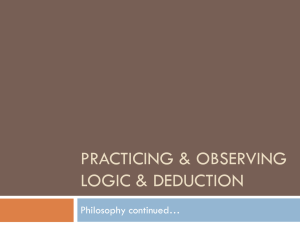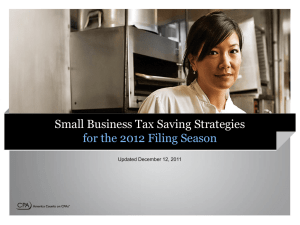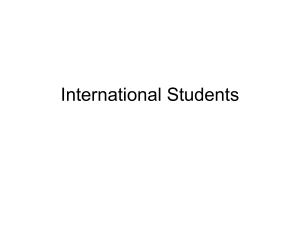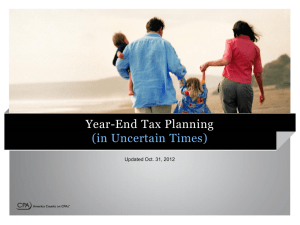Income-tax
advertisement
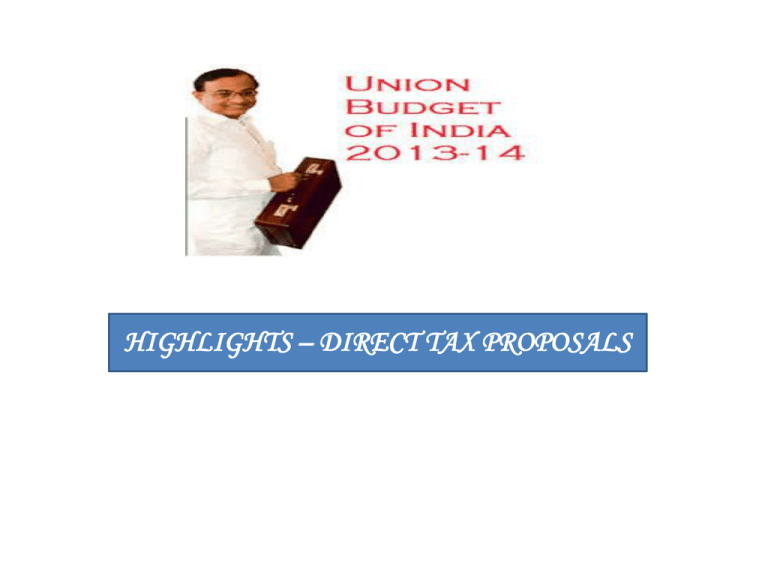
HIGHLIGHTS – DIRECT TAX PROPOSALS AGENDA Budget Highlights/Statistics Tax Rates Additional Resource Mobilization Measures to Promote Socio-Economic Growth Relief and Welfare Measures Widening of Tax Base and Anti Tax Avoidance Measures Rationalisation Measures BUDGET STATISTICS 2013 TOTAL SIZE OF BUDGET – Rs.16,65,298 (LY original Rs. 14,90,925 Revised Rs. 14,30,825) Particular Receipt (Crores) (In Crores) Expenditure (Crores) Revenue Rs.10,56,331 Rs.14,36,169 Borrowings Rs.5,42,499 (Interest cost- Rs.3,70,684) Capital Rs.66,468 Rs.2,29,129 Total Rs.16,65,298 Rs.16,65,298 Revenue Deficit Revenue From Rs.3,79,838 cr. (LY Original Rs. 3,50,424 cr., Revised - Rs. 3,91,244 cr.) Est. 13-14 Revised Estimate Original Estimate (Crores) 12-13 (Crores) 12-13 (Crores) Direct Tax Rs.6,68,109 Rs.5,65,835 Rs.5,70,257 Custom Rs.1,87,308 Rs.1,64,853 Rs.1,86,694 Central Excise Rs.1,97,554 Rs.1,71,996 Rs.1,94,350 Service Tax Rs.1,80,141 Rs.1,32,697 Rs.1,24,000 Revenue Deficit – C.Y. at 3.9% & 13-14 at 3.3% Fiscal Deficit – C.Y. at 5.2% & 13-14 at 4.8% GDP Growth – 5 to 5.5% BUDGET HIGHLIGHTS 2013 Tax Proposal on DT to yield Rs. 13,300 crores & Indirect Tax to yield Rs. 4,700 crores DTC to be put in House before end of the Budget Session Modified provisions of GAAR will come into effect from 01.04.2016 A sum of Rs. 9000 crores towards 1st installment of balance of CST compensation provided A onetime scheme called ‘Voluntary Compliance Encouragement Scheme’ proposed to be introduced for truthful declaration of ST dues since 01.10.2007 Proposal to carve out PMGSY-II & allocate a portion of funds to new programme that will benefit States such as AP, Haryana, Karnataka, Maharashtra, Punjab & Rajasthan. Target of skilling 50 million people in 12th Plan period, inc. 9 million in 13-14 Promises made to Women, Youth & Poor - A fund ‘ Nirbhaya Fund’ to be setup with govt. contribution of Rs. 1,000 crores to empower, keep safe & secure girl children & women. - National Skill Development Corporation to set the curriculum & standards for training in different skills to Youth. Rs 1,000 crores set apart for this scheme. - To the poor of India, direct benefit transfer scheme will be rolled out throughout the country during the term of UPA govt. with the motive ‘ Aapka Paisa Aapke Haath’ No change in basic tax rate since even a moderate increase in threshold limit would have severely erode the tax base. However, rebate of Rs. 2000 for individuals resident in India having total income up to Rs 5 lacs. Section 87A inserted w.e.f. A.Y. 14-15 to provide tax relief to individual tax payers whose TI does not exceed Rs. 5 lacs by proposing to provide a rebate equal to amount of income-tax payable on TI or an amount of Rs. 2,000/-,whichever is less. This is a case of rebate from tax & not increase in the basic exemption limit so that tax base is not eroded (Analysis - Rebate is not available to HUF & AOP, 1.8 crores tax payers would be benefited to the value of Rs. 3,600 crores) In case of Individual, HUF, AOP, Firm, Co-op Society & Local Authorities where TI exceeds Rs. 1 crores, Surcharge @10%. There are only 42,800 such persons in this category. In case of companies, surcharge would be as under:Surcharge Domestic Companies Foreign Companies Where TI exceeds Rs.1 crores but doesn’t exceed Rs.10 crores 5% (Existing) 2% (Existing) Where TI exceeds Rs. 10 crores 10% 5% (Analysis – Surcharge on domestic companies between Rs. 1 crores to Rs. 10 crores bracket is lower than surcharge in case of Individual, HUF, AOP, Firm, Co-operative Society & Local Authorities) Additional surcharge will be in force for only 1 year (Para 129 of the Speech of FM). Thus, it is much debated tax on super rich. B. ADDITIONAL RESOURCE MOBILISATION (2 Provisions) Commodities Transaction Tax – Chapter VII of Finance Bill New tax proposed to be levied on ‘Taxable commodities transaction’ from the date notified by CG. Tax proposed to be levied @0.01% payable by seller on taxable commodities transactions entered into in a recognized association. It is the same rate as applicable to equity futures. ‘Taxable commodities transaction’ to mean a transaction of sale of commodity derivatives in respect of commodities, other than agricultural commodities, traded in recognized associations. Commodity Derivative means:- A contract for delivery of goods which is not a ready delivery contract - A contract for differences which derives its vale from prices or indices of prices (a) of such underlying goods (b) of related service & rights such as warehousing & freight (c) with reference to weather & similar events & activities – having a bearing on the commodity sector Recognized Association means an association to which recognition for the time being has been granted by CG u/s 6 in respect of goods or classes of goods specified in such recognition – [Forwards Contract (Regulation) Act, 1952] Provisions with regard to collection and recovery of CTT, furnishing of returns, assessment procedure, power of AO, chargeability of interest, levy of penalty, institution of prosecution, filing of appeal, power to the Central Government, etc. have also been provided. Amendment proposed in sec. 36 w.e.f. 01.04.2014 to provide that an amount equal to CTT paid by assessee in respect of taxable commodities transactions entered into in the course of his business during the previous year shall be allowable as deduction, if the income arising from such taxable commodities transactions is included in the income computed under the head “Profits and gains of business or profession”. In Para 149 of Speech, FM stated that there is no distinction between derivative trading in securities market & derivative trading in commodities market. Trading in commodity derivatives will not be considered as ‘speculative transaction’. [Analysis - No amendment in sec. 43(5) to consider derivative transaction in commodity in recognized association as non speculative business] Taxation of Income by way of Royalty or FTS Section 115A provides for tax on income by way of Royalty and Fees for technical services (FTS) to non residents @10%. Majority of tax treaties allow India to levy tax on gross amount of royalty at rates ranging from 10% to 25%, whereas the tax rate as per section 115A is 10%. In order to correct this anomaly, tax rate in case of non-resident taxpayer, in respect of income received by way of royalty and fees for technical services under an agreement entered after 31.03.1976 is proposed to be increased from 10% to 25%. Amendment effective from 01.04.2014 i.e. A.Y. 14-15 c. MEASURES TO PROMOTE SOCIO-ECONOMIC GROWTH Incentive for acquisition and installation of new plant or machinery by manufacturing company New section 32AC proposed to be inserted w.e.f. A.Y. 14-15 in order to encourage substantial investment in new plant or machinery by company engaged in the business of manufacture of an article or thing Investment of sum of more than Rs.100 crore in aggregate during period 01.04.13 to 31.03.15 Deduction shall be allowed as under:A.Y. 14-15 15% of actual cost of new asset, if aggregate cost exceeds Rs.100 crore A.Y. 15-16 15% of actual cost of new asset minus deduction if any allowed above Transfer of P&M restricted for a period of 5 years. Restriction not to be applied in case of amalgamation or demerger but shall continue to apply to amalgamated company or resulting company. Analysis-It is an incentive allowable in computing income from business. It would not go to reduce the cost of asset for claiming depreciation) Extension of the sunset date u/s 80IA for the power sector It is proposed to amend provisions of sec. 80IA(4)(iv) so as to extend the terminal date by a further period of one year i.e. up to 31st March, 2014 D. RELIEF & WELFARE MEASURES (13 Provisions) Deduction in respect of interest on loan sanctioned during F.Y. 2013-14 for acquiring residential house property A new section 80EE proposed to be inserted to allow deduction to individual on the interest payable on loan taken from any financial institution for the purpose of acquisition of residential house property. Deduction is restricted to Rs. 1 lacs. If the deduction claimed in A.Y. 14-15 is less than Rs. 1 lacs, the balance amount would be allowed in A.Y. 15-16 Deduction would be allowed only if Loan is sanctioned between 01.04.2013 to 31.03.2014 Amount of loan sanctioned does not exceed Rs. 25 lacs Value of residential house property does not exceed Rs. 40 lacs Assessee does not own any residential house property on the date of sanction of loan Where deduction for interest is allowed in this section, such interest shall not be allowed under any other provision of the Act (Analysis – If interest paid on SOP is Rs. 2.50 lacs, Rs. 1.50 lacs can be claimed u/s 24 & balance Rs. 1 lacs u/s 80EE) Raising the limit of percentage of eligible premium for life insurance policies of persons with disability or disease As per section 80C(3A), amount of any premium or other payment made on an insurance on the life of a person where the policy is issued on or after 1.04.2012 is restricted to 10% of the actual capital sum assured. Further, as per section 10(10D), any sum received under a life insurance policy is exempt subject to the condition that the premium paid for such policy does not exceed 10% of the ‘actual capital sum assured’. It is proposed to amend section 80C(3A) w.e.f. A.Y. 14-15 to provide that deduction under said section on account of premium paid in respect of a policy issued on or after 01.04.2013 for insurance on the life of following person shall be allowed to the extent the premium paid does not exceed 15% of the actual capital sum assured: a person with disability or a person with severe disability as referred to in section 80U, or suffering from disease or ailment as specified in the rules made u/s 80DDB It is also proposed to amend section 10(10D) w.e.f. A.Y. 14-15 to provide that any sum received under an insurance policy issued on or after 01.04.2013 for the insurance on the life of any person referred to above shall be exempt u/s 10(10D) if the premium payable for any of the years during the term of the policy does not exceed 15% of the actual capital sum assured. Deduction for contribution to Health Schemes similar to CGHS Sec. 80D provides deduction of whole of the amount paid in P.Y. out of the income chargeable to tax of assessee, being an individual, to effect or to keep in force an insurance on his health or the health of the family or any contribution made towards the Central Government Health Scheme (CGHS) or any payment made on account of preventive health check-up of assessee or his family, as does not exceed in aggregate Rs. 15,000/-. It is proposed to amend section 80D w.e.f A.Y. 14-15, so as to allow the benefit of deduction under this section within the said limit, in respect of any payment or contribution made by the assessee to such other health scheme as may be notified by the Central Government. Scope of deduction under RGESS u/s 80CCG expanded Existing provisions of sec. 80CCG provides that where a resident individual i.e. a new retail investor whose GTI does not exceed Rs. 10 lacs has acquired listed equity shares in accordance with Rajiv Gandhi Equity Savings Scheme notified by CG, he shall be allowed deduction of 50% of the amount invested in such equity shares to the extent that the said deduction does not exceed Rs. 25,000/-. The deduction is a onetime deduction and is available only in one assessment year in respect of the amount so invested. Under this scheme, investment is to be made in BSE Top 100 shares list. It is proposed to amend section 80CCG w.e.f. A.Y. 14-15 so as to provide that investment in listed units of an equity oriented fund shall also be eligible for deduction. It is also proposed to provide that “equity oriented fund” shall have the meaning assigned to it in section 10(38). It is further proposed to provide that deduction under this section shall be allowed for 3 consecutive A.Y.’s, beginning with A.Y. relevant to P.Y. in which the listed equity shares or listed units were first acquired by the new retail investor whose GTI for the relevant A.Y. does not exceed Rs. 12 lacs. Exemption to income of Investor Protection Fund of depositories Section 10(23EA) provides that income by way of contributions from a recognized stock exchange received by a Investor Protection Fund set up by the recognized stock exchange shall be exempt from taxation. It is proposed that income, by way of contribution from a depository, of the Investor Protection Fund set up by the depository in accordance with the regulations prescribed by SEBI will not be included while computing the total income subject to same conditions as are applicable in respect of exemption to an Investor Protection Fund set up by recognized stock exchanges. Amendment effective from 01.04.2014 i.e. A.Y. 14-15. 100% deduction for donation to National Children’s Fund Sec. 80G allows deduction @50% in case of donations made to National Children’s Fund It is proposed w.e.f. A.Y. 14-15 to allow 100% deduction in respect of any sum paid to National Children’s Fund being a fund of national importance. Exemption to National Financial Holdings Company Limited The Specified Undertaking of Unit Trust of India (SUUTI) was created vide Unit Trust of India (Transfer of Undertaking and Repeal) Act, 2002 as the successor of Unit Trust of India (UTI). Exemption from Income-tax was available to SUUTI in respect of its income up to 31.03.2014. SUUTI has been wound up and is succeeded by a new company wholly owned by the CG. It has been incorporated on 07.06.2012 as National Financial Holdings Company Limited (NFHCL). In order to provide exemption on the lines of SUUTI to NFHCL, it is proposed to amend section 10 to grant exemption to NFHCL in respect of its income accruing, arising or received on or before 31.03.2014. Amendment w.r.e.f. 01.04.2013 i.e. A.Y. 13-14 & A.Y. 14-15. Lower rate of tax on dividends received from foreign companies Section 115BBD provides for taxation of gross dividends received by an Indian company from a specified foreign company (in which it has shareholding of 26% or more) @15% if such dividend is included in TI for F.Y. 2012-13 i.e. A.Y. 2013-14. It is proposed to extend this benefit for 1 more year. Amendment effective from 01.04.2014 i.e. A.Y. 14-15. Removal of the cascading effect of Dividend Distribution Tax (DDT) Section 115O provides for taxation of distributed profits of domestic company @15%. Section 115BBD provides for taxation of gross dividend received by an Indian Company from a specified foreign company having shareholding of 26% or more @15% Section 115O provides for reduction of the amount of dividend received from its subsidiary if such subsidiary has paid DDT but the amount of dividend received by it from its foreign company was not reduced as that company has not paid DDT. Therefore, section 115O is amended to provide that where dividend is received by domestic company from a foreign subsidiary (holding more than 50% equity shares) on which tax u/s 115BBD is paid by the holding domestic company, any dividend distributed by the holding company in the same year to the extent of such dividend shall not be subject to DDT u/s 115O. Concessional rate of withholding tax on interest in case of certain rupee denominated long-term infrastructure bonds Interest payment to NR on money borrowed in foreign currency by an Indian Co. under a loan agreement or issue of LT Infra Bond approved by CG is subject to concessional tax rate of 5%. It is proposed to provide that where a NR deposit foreign currency in designated bank account & such money as converted in rupee is utilized for subscription to a LT Infra Bond issue of an Indian co. in Indian rupees, then borrowing by the company shall be deemed to be foreign currency entitled to benefit of reduced rate of tax on payment of interest to NR. Taxation of Securitization Trust Where income of trust consists of profit & gains of business, it is taxed at MMR u/s 161. Certain entities set up in form of trust undertakes securitization activities. Taxing them at MMR is considered restrictive when the investors of the trust are persons exempt from tax like mutual fund. Therefore, to facilitate securitization process , a special taxation regime is proposed by amending section 10 & inserting New Chapter XII-EA. The salient features are Income from securitization activity of such trust will be exempt provided it is regulated by SEBI or RBI On income distributed to investors, tax shall be levied at 25% where distribution is to Individual & HUF & @30% in other cases. No tax if such person is exempt from tax. Distributed income received by investor would be exempt from tax in the hands of investor Securities Transaction Tax (STT) No STT payable by the purchaser. On sale of delivery based units, rate reduced from 0.1% to 0.001% On sale of futures, rate reduced from .017% to .01% On sale of units of equity oriented fund to the mutual fund, rate reduced from 0.25% to 0.001% Pass through Status to certain Alternative Investment Fund Sec. 10(23FB) provides that any income of VCC or VCF from investment in VCU shall be exempt provided they satisfy the conditions as provided in SEBI (VCF) Regulation, 1996. Section 115U provides that income accruing or arising or received by a person out of investment made in VCC or VCF shall be taxable in his hand in same manner, if he had made direct investment in VCU SEBI (Alternative Investment Fund) Regulations 2012 has replaced SEBI (VCC) Regulation, 1996 from 21.05.2012 Therefore, section 10(23FB) proposed to be amended to provide similar pass through benefit if following conditions are satisfied: at least 2/3rd of investible funds are invested in unlisted equity shares of VCU no investment is made by AIF in VCU which is an associate co. units/shares of trust/co. set up as AIF are not listed on recog. stock exchange E. WIDENING OF TAX BASE AND ANTI TAX AVOIDANCE MEASURES ( 4 Provisions) TDS on transfer of certain immovable properties (other than agricultural land) New section 194IA proposed to be inserted w.e.f. 01.06.2013 to provide that every transferee, at the time of making payment or crediting of any sum as consideration for transfer of immovable property (other than agricultural land) to a resident transferor, shall deduct tax @ 1% of such sum. Section is not applicable where the total amount of consideration for the transfer of an immovable property is less than Rs. 50 lacs (Analysis - Similar proposal by way of Section 194LLA provided in Finance Bill 2012 but dropped while enacting the Finance Act, Practical difficulty in implementation) Computation of income under the head “Profits and gains of business or profession” for transfer of immovable property in certain cases Presently section 50C does not apply to transfer of immovable property, held by the transferor as stock-in-trade. New section 43CA proposed to be inserted w.e.f. 14-15 to provide that where the consideration for the transfer of an asset (other than capital asset), being land or building or both, is less than the stamp duty value, than the value so adopted or assessed or assessable shall be deemed to be the FVOC for the purposes of computing income under the head “PGBP”. The provisions of sec. 50C(2) & 50C(3) for determination of value would apply. The amendment would make various judgments of High Court holding that sec. 50C isn’t applicable to business asset, nugatory [CIT Vs. Thiruvengadam Investments Pvt. Ltd. 320 ITR 345 (Mad.)] If there is a time gap between the date of agreement and date of registration than the stamp duty value may be taken as on the date of the agreement for transfer & not as on date of registration of such transfer. This exception shall apply only in those cases where amount of consideration or a part thereof for the transfer has been received by any mode other than cash on or before the date of the agreement. (Analysis - Similar amendment is not made in section 50C) Taxability of immovable property received for inadequate consideration As per existing provisions of sec. 56(2)(vii)(b), where any immovable property is received by an individual or HUF without consideration and the stamp duty value of which exceeds Rs.50,000/-, stamp duty value of such property would be charged to tax in the hands of the individual or HUF as Income from other sources. This section does not cover a situation of inadequate consideration. Accordingly, this section has been proposed to be amended w.e.f. A.Y. 14-15 to provide that where any immovable property is received for a consideration which is less than the stamp duty value of the property by an amount exceeding Rs.50,000/-, the stamp duty value of such property as exceeds such consideration, shall be chargeable to tax in the hands of individual or HUF as income from other sources. If there is a time gap between the date of agreement and date of registration than the stamp duty value may be taken as on the date of the agreement & not as on date of registration. This exception shall apply only in those cases where amount of consideration or a part thereof has been paid by any mode other than cash on or before the date of the agreement. This provision was also introduced by FA 2009 but withdrawn w.r.e. by FA 2010 Additional Income-tax on distributed income by company for buy-back of unlisted shares At present, sec. 115O provides for levy of DDT. Consequently dividend received by shareholders is exempt u/s 10(34). Consideration received by shareholder on buy back of shares by co. is not treated as dividend but is taxed as capital gain u/s 46A. Unlisted companies to avoid tax resort to buy back of shares as same is either not taxed because of indexation benefit or taxed at lower rate. New Chapter XII-DA inserted w.e.f. 01.06.2013 to provide that consideration paid by the company for purchase of its own unlisted shares which is in excess of the sum received by the company at the time of issue of such shares (distributed income) will be charged to tax and the company would be liable to pay additional income-tax @ 20% of the distributed income paid to the shareholder. The additional income-tax payable by the company shall be the final tax on similar lines as DDT. New sec. 10(34A) inserted w.e.f. 01.04.2014 to provide that income arising to the shareholders in respect of such buy back by the company would be exempt where the company is liable to pay the additional income-tax on the buy-back of shares. (Analysis – The effect of section is that the tax which was payable after indexation as capital gain would now be taxed at flat rate of 20%) F. RATIONALISATION MEASURES (18 Provisions) General Anti-Avoidance Rule (GAAR) GAAR shall apply from A.Y. 2016-17 instead of A.Y. 2014-15. Sec. 96(1) amended to provide that only an arrangement, the main purpose of which is to obtain a tax benefit, would be considered as an IAA as against existing provision that it should be “the main purpose or one of the main purposes”. Factors like period of time for which the arrangement had existed; the fact of payment of taxes by assessee etc. would be relevant but not sufficient to determine whether the arrangement is an IAA as against current provision which provided that these factors would not be relevant. New Section 97(1)(d) inserted to provide that an arrangement shall also be deemed to lack commercial substance, if it does not have a significant effect upon the business risks, or net cash flows of any party to the arrangement apart from any effect attributable to the tax benefit that would be obtained but for the application of Chapter X-A. General Anti-Avoidance Rule (GAAR) Sect. 144BA amended to provide that the Approving Panel shall consist of:- Chairperson who is or has been a Judge of a High Court One Member of the Indian Revenue Service not below the rank of CCIT One Member who shall be an academic or scholar having special knowledge of matters such as direct taxes, business accounts and international trade practices. Directions issued by Approving Panel shall be binding on assesses as well as the IT authorities and no appeal against such directions can be made under the provisions of the Act as against current provision proving that directions will be binding only on AO. CG may constitute one or more Approving Panels as may be necessary and the term shall be ordinarily for 1 year and may be extended from time to time upto 3 years. Now the two separate definition of “associated person” and “connected person” will be combined and there will be only one inclusive provision defining a ‘connected person’. Rationalization of tax on distributed income by Mutual Funds Sec. 115R proposed to be amended w.e.f. 01.06.2013 to provide that in order to uniform taxation for all types of funds, other than equity oriented fund, the rate of tax on distributed income to be increased from 12.5% to 25% in all cases where distribution is made to an individual or a HUF. In order to bring parity in taxation of income from investment made by NR Investor in an IDF whether set as IDF-NBFC or IDF-MF, it is proposed to amend sec. 115R to provide that tax @5% on income distributed shall be payable in respect of income distributed by a Mutual Fund under an IDF scheme to a NR Investor Enabling provisions for facilitating electronic filing of annexure-less return of net wealth New sections 14A and 14B proposed to be inserted w.e.f. 01.06.2013 in Wealth-tax Act for filing of annexure-less return of income in electronic form by certain class of income-tax assesses on similar lines as in sec. 139C & 139D of IT Act. Amendment in the definition of Capital Asset Under existing sec. 2(14)(iii), (a) agricultural land situated within municipality or cantonment board having population of not less than 10,000 or (b) agricultural land situated within such distance not exceeding 8kms from municipality or cantonment board as notified by CG forms part of capital asset. Sec. 2(14)(iii)(b) is proposed to be amended as under: The distance is to be measured aerially (shortest aerial distance) & not by approach road. The amendment is made to overrule the judgment in case of CIT Vs. Satinder Pal Singh 33 DTR 281 (P&H) Instead of referring to the notification of CG, for cities & distance, following three categories has been provided & if the agricultural land is situated therein, it would be a capital asset In case of municipality or cantonment board having population between: Aerial Limits From 10,001 to 1,00,000 Upto 2 Kms From 1,00,001 to 10,00,000 Upto 6 Kms Exceeding 10,00,000 Upto 8 Kms Similar amendment made in sec. 2(1A) & definition of urban land in WT Act Disallowance of certain fee, charge, etc. in the case of State Government Undertakings A new sub clause (iib) in section 40 is proposed to be inserted w.e.f. 14-15 to provide that any amount paid by way of royalty, fee, charge, by whatever named called, which is levied exclusively, or any amount appropriated, directly or indirectly, from a State Government undertaking, by the State Government, shall not be allowed as deduction for the purposes of computation of income of such undertakings under the head “PGBP”. State Government undertaking is separately defined in this section. Keyman insurance policy Existing sec. 10(10D) exempts sum received under life insurance policy other than a KMIP. Where policy taken under this scheme are assigned to the keyman before its maturity & keyman pays the remaining premium on this policy, sum received under the policy is claimed exempt on the ground that policy is no longer KMIP. To plug this loophole, it is proposed to amend sec.10(10D) w.e.f. A.Y. 14-15 to provide that a KMIP which has been assigned to any person during its term, with or without consideration, shall continue to be treated as a KMIP. Contribution not to be in cash to political parties or electoral trust for deduction u/s 80GGB & section 80GGC With a view to discourage cash payments by the contributors, it is proposed to amend section 80GGB and 80GGC w.e.f. A.Y. 14-15 to provide that no deduction shall be allowed under section in respect of any sum contributed by way of cash by Indian Co. to any political party or electoral trust. Clarification of phrase “tax due” for the purposes of recovery in certain cases Sec. 179 of the Act provides that where tax due from a private co. can’t be recovered from it, then director can be made liable for the payment if non recovery is attributable to their negligence etc. Courts have held that tax due would not include interest & penalty [H. Ebrahim & Ors. Vs. DCIT 332 ITR 122 (Kar.)] It is proposed to insert Explanation w.e.f. 01.06.2013 to clarify that for the purposes of section 179, the expression “tax due” includes penalty, interest or any other sum payable under the Act. Deduction for additional wages in certain cases Sec. 80JJAA provides for deduction of an amount equal to 30% of additional wages paid to the new regular workmen employed by an Indian company in its industrial undertaking engaged in manufacture or production of article or thing. It is proposed to amend sec. 80JJAA w.e.f. A.Y. 14-15 to provide that deduction shall be of an amount equal to 30% of additional wages paid to the new regular workmen employed by the assessee in such factory It is also proposed to provide that deduction under this section shall not be available if the factory is hived off or transferred from another existing entity or acquired by the assessee co. as a result of amalgamation with another co. Tax Residency Certificate To get the benefit of DTAA, sec. 90(4) & 90A(4) inserted by FA’12 makes submission of TRC as a condition for availing the benefit of agreements. It is proposed to amend these section w.r.e.f. A.Y. 13-14 to provide that submission of a tax residency certificate is a necessary but not a sufficient condition for claiming benefits under the agreements Direction for special audit under sub-section (2A) of sec. 142 Special audit can be directed by the AO apart from the nature & complexity of accounts, for the following reasons also:volume of the accounts, doubts about the correctness of the accounts, multiplicity of transactions in the accounts specialized nature of business activity of the assessee Amendment will take effect from 01.06.2013 Penalty u/s 271FA for non-filing of Annual Information Return Existing sec. 271FA provides for penalty of Rs 100/day if the AIR u/s 285BA(1) is not furnished within the prescribed time under that sub section. Apart from continuing this penalty, it is further proposed w.e.f. A.Y. 14-15 that where such person fails to furnish the return within the period specified in notice under section 285BA(5), he shall be liable to pay, Rs 500/day during which the failure continues beginning from the day immediately following the day on which the time specified in such notice for furnishing the return expires Exclusion of time in computing the period of limitation for completion of assessments and reassessments It is proposed to amend clause (iii) of Explanation 1 of sec. 153 w.e.f. 01.06.2013 to provide that the period commencing from the day on which the AO directs the assessee to get his accounts audited u/s 142(2A) & ending with the last day on which report is required to be furnished or where such direction is challenged before Court, ending with the date on which the order setting aside such direction is received by the Commissioner, shall be excluded in computing the period of limitation Extension of time for approval in Part A of the Fourth Schedule to the Income-tax Act, 1961 With a view to provide further time to the EPFO to decide on the pending applications seeking exemption under section 17 of the EPF & MP Act, it is proposed to amend the first proviso, so as to extend the time limit from 31st March, 2013 to 31st March, 2014. Clarification for amount to be eligible for deduction as bad debts in case of banks In order to clarify the scope and applicability of provision of clause (vii), (viia) of sub-section (1) and sub-section (2), it is proposed to insert an Explanation in clause (vii) of section 36(1) stating that for the purposes of the proviso to section 36(1)(vii) and section 36(2)(v), only one account as referred to therein is made in respect of provision for bad and doubtful debts under section 36(1)(viia) and such account relates to all types of advances, including advances made by rural branches. Therefore, for an assessee to which clause (viia) of section 36(1) applies, the amount of deduction in respect of the bad debts actually written off under section 36(1)(vii) shall be limited to the amount by which such bad debts exceeds the credit balance in the provision for bad and doubtful debts account made under section 36(1)(viia) without any distinction between rural advances and other advances. THANK YOU
